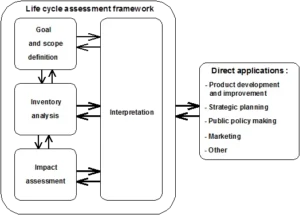Methodology used in our LCA case studies

We use Life cycle assessment (LCA) method to assess the environmental impacts of a product or service. LCA looks on the whole life cycle. Hence, the environmental impacts of a product are evaluated from cradle to grave, which means from the resource extraction up to the disposal of the product. ESU uses the method to analyse and optimize products, to compare different products with each other or to declare the environmental impacts.
The general procedure of conducting an LCA in ISO 14040 and ISO 14044 is standardised by the International Organization for Standardization (ISO). An LCA consists of four stages:
- Goal and Scope Definition
- Inventory Analysis (LCI)
- Impact Assessment (LCIA)
- Interpretation
The four stages of LCA
The Goal Definition (phase 1) covers the description of the object of investigation. The environmental aspects to be considered in the interpretation are also defined here. The Scope Definition includes the way of modelling the object of investigation, the identification as well as the description of the processes of importance towards the object of investigation. The functional unit, which determines the base for the comparison, is defined here.
The direct environmental impacts (emissions and ressource uses), the amount of semi-finished products, auxiliary materials and energy of the processes involved in the life cycle are determined and inventoried in the Inventory Analysis (phase 2). This data is set in relation to the object of investigation, i.e. the functional unit. The final outcome consists of the cumulative resource demands and emissions of pollutants.
The Inventory Analysis provides the basis for the Impact Assessment (phase 3). Applying current valuation methods, e.g. eco-indicator, ecological scarcity or CML, to the inventory results in indicator values that are used and referred to in the interpretation.
The results of the inventory analysis and the impact assessment are analysed and commented in the Interpretation (phase 4) according to the initially defined goal and scope of the LCA. Final conclusions are drawn and recommendations stated.
LCA case studies by ESU
ESU-services investigates all types of products and services in LCA case studies. Some working examples are:
- Investigation of aluminium packages including the full life cycle of the packed product
- Comparison of energy systems
- Comparison of mineral water and tap water
- Comparison of different conversion processes for BTL-fuels (biomass-to-liquid)
- Energy analysis of beef from Argentina and LCA several other food products
- LCA of photovoltaics and other types of electricity production
- LCA of skiing, cruises and other types of holidays
A full list of published case studies can be found in the section on publications. A full list of projects and some information of working examples can be found in another section of this webpage.